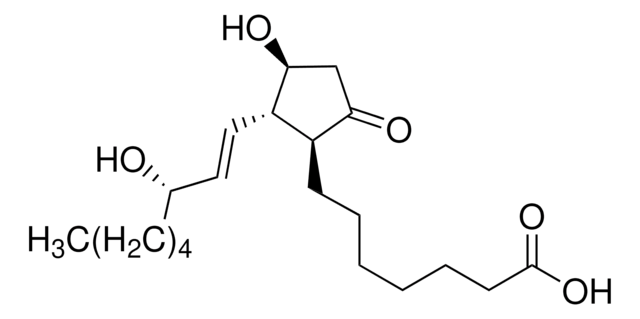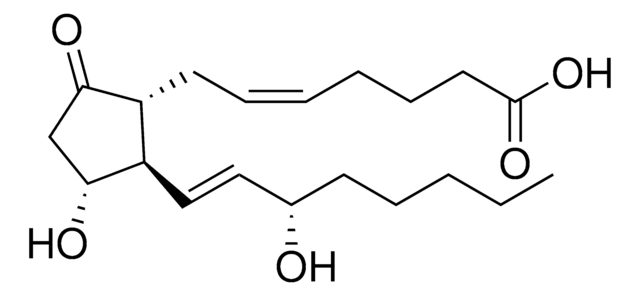P7265
Prostaglandin A1
≥98% (HPLC), powder, NF-κB inhibitor
Synonym(s):
(13E,15S)-15-Hydroxy-9-oxoprosta-10,13-dien-1-oic acid, PGA1
About This Item
product name
Prostaglandin A1, synthetic
biological source
synthetic
Quality Level
assay
≥98%
form
powder
storage temp.
−20°C
SMILES string
O=C1[C@H](CCCCCCC(O)=O)[C@@H](/C=C/[C@H](CCCCC)O)C=C1
InChI
1S/C20H32O4/c1-2-3-6-9-17(21)14-12-16-13-15-19(22)18(16)10-7-4-5-8-11-20(23)24/h12-18,21H,2-11H2,1H3,(H,23,24)/b14-12+/t16-,17-,18+/m0/s1
InChI key
BGKHCLZFGPIKKU-LDDQNKHRSA-N
Looking for similar products? Visit Product Comparison Guide
Biochem/physiol Actions
signalword
Danger
hcodes
Hazard Classifications
Acute Tox. 4 Oral - Repr. 1B
Storage Class
6.1C - Combustible acute toxic Cat.3 / toxic compounds or compounds which causing chronic effects
wgk_germany
WGK 3
flash_point_f
Not applicable
flash_point_c
Not applicable
ppe
Eyeshields, Gloves, type N95 (US)
Certificates of Analysis (COA)
Search for Certificates of Analysis (COA) by entering the products Lot/Batch Number. Lot and Batch Numbers can be found on a product’s label following the words ‘Lot’ or ‘Batch’.
Already Own This Product?
Find documentation for the products that you have recently purchased in the Document Library.
Customers Also Viewed
Related Content
Discover Bioactive Small Molecules for Lipid Signaling Research
Our team of scientists has experience in all areas of research including Life Science, Material Science, Chemical Synthesis, Chromatography, Analytical and many others.
Contact Technical Service


